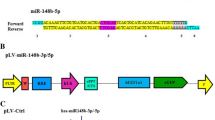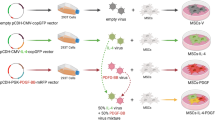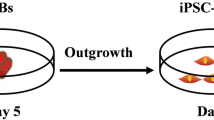Abstract
Mesenchymal stem cells (MSCs) are multipotent progenitor nonhematopoietic cells that have emerged as an attractive cell source for tissue engineering. Biglycan (BGN), an extracellular matrix component, has been reported to play a crucial role in bone formation. However, the role of BGN in MSCs remains unknown. Using lentiviral gene delivery, we sought to investigate the cellular effects of BGN on proliferation and osteogenic potential of bone marrow-derived MSCs in vitro. We found that MSCs with lentiviral transduction of BGN exhibited an increase in growth ability and the percentage of the S phase, together with significantly reduced mRNA levels of p21 and p27. Furthermore, lentiviral transduction of BGN in MSCs also increased alkaline phosphatase activity, stimulated the mineralization capacity, and enhanced expression of Runx2, Osteocalcin, collagen I, transforming growth factor (TGF)-β1, p-Smad2 and p-Smad3. Taken together, our data suggest that BGN overexpression positively regulates proliferation and osteogenic potential of MSCs, and TGF-β signaling pathway may be involved in BGN-induced osteogenic potential of MSCs.





Similar content being viewed by others
References
Bi Y, Stuelten CH, Kilts T, Wadhwa S, Iozzo RV, Robey PG, Chen XD, Young MF (2005) Extracellular matrix proteoglycans control the fate of bone marrow stromal cells. J Biol Chem 280(34):30481–30489. doi:10.1074/jbc.M500573200
Bolton K, Segal D, Walder K (2012) The small leucine-rich proteoglycan, biglycan, is highly expressed in adipose tissue of Psammomys obesus and is associated with obesity and type 2 diabetes. Biologics 6:67–72. doi:10.2147/BTT.S27925
Bonab MM, Alimoghaddam K, Talebian F, Ghaffari SH, Ghavamzadeh A, Nikbin B (2006) Aging of mesenchymal stem cell in vitro. BMC Cell Biol 7:14. doi:10.1186/1471-2121-7-14
Chen XD, Shi S, Xu T, Robey PG, Young MF (2002) Age-related osteoporosis in biglycan-deficient mice is related to defects in bone marrow stromal cells. J Bone Miner Res 17(2):331–340. doi:10.1359/jbmr.2002.17.2.331
Donzelli E, Salvade A, Mimo P, Vigano M, Morrone M, Papagna R, Carini F, Zaopo A, Miloso M, Baldoni M, Tredici G (2007) Mesenchymal stem cells cultured on a collagen scaffold: in vitro osteogenic differentiation. Arch Oral Biol 52(1):64–73. doi:10.1016/j.archoralbio.2006.07.007
Gotte M, Sofeu Feugaing DD, Kresse H (2004) Biglycan is internalized via a chlorpromazine-sensitive route. Cell Mol Biol Lett 9(3):475–481
Gu X, Ma Y, Xiao J, Zheng H, Song C, Gong Y, Xing X (2012) Up-regulated biglycan expression correlates with the malignancy in human colorectal cancers. Clin Exp Med 12(3):195–199. doi:10.1007/s10238-011-0155-4
Hering S, Isken E, Knabbe C, Janott J, Jost C, Pommer A, Muhr G, Schatz H, Pfeiffer AF (2001) TGFbeta1 and TGFbeta2 mRNA and protein expression in human bone samples. Exp Clin Endocrinol Diabetes 109(4):217–226. doi:10.1055/s-2001-15109
Izadpanah R, Trygg C, Patel B, Kriedt C, Dufour J, Gimble JM, Bunnell BA (2006) Biologic properties of mesenchymal stem cells derived from bone marrow and adipose tissue. J Cell Biochem 99(5):1285–1297. doi:10.1002/jcb.20904
Karaoz E, Aksoy A, Ayhan S, Sariboyaci AE, Kaymaz F, Kasap M (2009) Characterization of mesenchymal stem cells from rat bone marrow: ultrastructural properties, differentiation potential and immunophenotypic markers. Histochem Cell Biol 132(5):533–546. doi:10.1007/s00418-009-0629-6
Kimelman N, Pelled G, Gazit Z, Gazit D (2006) Applications of gene therapy and adult stem cells in bone bioengineering. Regen Med 1(4):549–561. doi:10.2217/17460751.1.4.549
Knippenberg M, Helder MN, Doulabi BZ, Bank RA, Wuisman PI, Klein-Nulend J (2009) Differential effects of bone morphogenetic protein-2 and transforming growth factor-beta1 on gene expression of collagen-modifying enzymes in human adipose tissue-derived mesenchymal stem cells. Tissue Eng Part A 15(8):2213–2225. doi:10.1089/ten.tea.2007.0184
Kocamaz E, Gok D, Cetinkaya A, Tufan AC (2012) Implication of C-type natriuretic peptide-3 signaling in glycosaminoglycan synthesis and chondrocyte hypertrophy during TGF-beta1 induced chondrogenic differentiation of chicken bone marrow-derived mesenchymal stem cells. J Mol Histol 43(5):497–508. doi:10.1007/s10735-012-9430-2
Lennon DP, Caplan AI (2006) Isolation of rat marrow-derived mesenchymal stem cells. Exp Hematol 34(11):1606–1607. doi:10.1016/j.exphem.2006.07.015
Livak KJ, Schmittgen TD (2001) Analysis of relative gene expression data using real-time quantitative PCR and the 2(-Delta Delta C(T)) method. Methods 25(4):402–408. doi:10.1006/meth.2001.1262
Marie PJ, Fromigue O (2006) Osteogenic differentiation of human marrow-derived mesenchymal stem cells. Regen Med 1(4):539–548. doi:10.2217/17460751.1.4.539
Ng F, Boucher S, Koh S, Sastry KS, Chase L, Lakshmipathy U, Choong C, Yang Z, Vemuri MC, Rao MS, Tanavde V (2008) PDGF, TGF-beta, and FGF signaling is important for differentiation and growth of mesenchymal stem cells (MSCs): transcriptional profiling can identify markers and signaling pathways important in differentiation of MSCs into adipogenic, chondrogenic, and osteogenic lineages. Blood 112(2):295–307. doi:10.1182/blood-2007-07-103697
Pittenger MF, Mackay AM, Beck SC, Jaiswal RK, Douglas R, Mosca JD, Moorman MA, Simonetti DW, Craig S, Marshak DR (1999) Multilineage potential of adult human mesenchymal stem cells. Science 284(5411):143–147
Schaefer L, Iozzo RV (2008) Biological functions of the small leucine-rich proteoglycans: from genetics to signal transduction. J Biol Chem 283(31):21305–21309. doi:10.1074/jbc.R800020200
Schaefer L, Hausser H, Altenburger M, Ugorcakova J, August C, Fisher LW, Schaefer RM, Kresse H (1998) Decorin, biglycan and their endocytosis receptor in rat renal cortex. Kidney Int 54(5):1529–1541. doi:10.1046/j.1523-1755.1998.00149.x
Shibata KR, Aoyama T, Shima Y, Fukiage K, Otsuka S, Furu M, Kohno Y, Ito K, Fujibayashi S, Neo M, Nakayama T, Nakamura T, Toguchida J (2007) Expression of the p16INK4A gene is associated closely with senescence of human mesenchymal stem cells and is potentially silenced by DNA methylation during in vitro expansion. Stem Cells 25(9):2371–2382. doi:10.1634/stemcells.2007-0225
Shimizu-Hirota R, Sasamura H, Kuroda M, Kobayashi E, Hayashi M, Saruta T (2004) Extracellular matrix glycoprotein biglycan enhances vascular smooth muscle cell proliferation and migration. Circ Res 94(8):1067–1074. doi:10.1161/01.RES.0000126049.79800.CA
Song R, Zeng Q, Ao L, Yu JA, Cleveland JC, Zhao KS, Fullerton DA, Meng X (2012) Biglycan induces the expression of osteogenic factors in human aortic valve interstitial cells via Toll-like receptor-2. Arterioscler Thromb Vasc Biol 32(11):2711–2720. doi:10.1161/ATVBAHA.112.300116
Wagner W, Horn P, Castoldi M, Diehlmann A, Bork S, Saffrich R, Benes V, Blake J, Pfister S, Eckstein V, Ho AD (2008) Replicative senescence of mesenchymal stem cells: a continuous and organized process. PLoS ONE 3(5):e2213. doi:10.1371/journal.pone.0002213
Wang B, Li GX, Zhang SG, Wang Q, Wen YG, Tang HM, Zhou CZ, Xing AY, Fan JW, Yan DW, Qiu GQ, Yu ZH, Peng ZH (2011) Biglycan expression correlates with aggressiveness and poor prognosis of gastric cancer. Exp Biol Med (Maywood) 236(11):1247–1253. doi:10.1258/ebm.2011.011124
Ward M, Ajuwon KM (2011) Regulation of pre-adipocyte proliferation and apoptosis by the small leucine-rich proteoglycans, biglycan and decorin. Cell Prolif 44(4):343–351. doi:10.1111/j.1365-2184.2011.00763.x
Weber CK, Sommer G, Michl P, Fensterer H, Weimer M, Gansauge F, Leder G, Adler G, Gress TM (2001) Biglycan is overexpressed in pancreatic cancer and induces G1-arrest in pancreatic cancer cell lines. Gastroenterology 121(3):657–667
Yamachika E, Tsujigiwa H, Matsubara M, Hirata Y, Kita K, Takabatake K, Mizukawa N, Kaneda Y, Nagatsuka H, Iida S (2012) Basic fibroblast growth factor supports expansion of mouse compact bone-derived mesenchymal stem cells (MSCs) and regeneration of bone from MSC in vivo. J Mol Histol 43(2):223–233. doi:10.1007/s10735-011-9385-8
Yamamoto K, Ohga N, Hida Y, Maishi N, Kawamoto T, Kitayama K, Akiyama K, Osawa T, Kondoh M, Matsuda K, Onodera Y, Fujie M, Kaga K, Hirano S, Shinohara N, Shindoh M, Hida K (2012) Biglycan is a specific marker and an autocrine angiogenic factor of tumour endothelial cells. Br J Cancer 106(6):1214–1223. doi:10.1038/bjc.2012.59
Young MF, Bi Y, Ameye L, Chen XD (2002) Biglycan knockout mice: new models for musculoskeletal diseases. Glycoconj J 19(4–5):257–262. doi:10.1023/A:1025336114352
Author information
Authors and Affiliations
Corresponding author
Rights and permissions
About this article
Cite this article
Wu, B., Ma, X., Zhu, D. et al. Lentiviral delivery of biglycan promotes proliferation and increases osteogenic potential of bone marrow-derived mesenchymal stem cells in vitro. J Mol Hist 44, 423–431 (2013). https://doi.org/10.1007/s10735-013-9497-4
Received:
Accepted:
Published:
Issue Date:
DOI: https://doi.org/10.1007/s10735-013-9497-4




